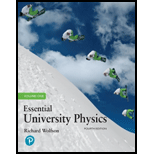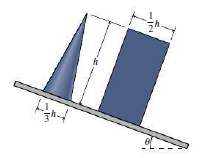
EBK ESSENTIAL UNIVERSITY PHYSICS, VOLUM
4th Edition
ISBN: 9780135272947
Author: Wolfson
Publisher: VST
expand_more
expand_more
format_list_bulleted
Concept explainers
Textbook Question
Chapter 12, Problem 55P
What condition on the coefficient of friction in Problem 48 will cause the block to slide before it tips?

FIGURE 12.27 Problem 48,49 and 50
Expert Solution & Answer
Want to see the full answer?
Check out a sample textbook solution
Students have asked these similar questions
pls help on these
pls help on these
20. Two small conducting spheres are placed on top of insulating pads. The 3.7 × 10-10 C sphere is fixed whie
the 3.0 × 107 C sphere, initially at rest, is free to move. The mass of each sphere is 0.09 kg. If the spheres
are initially 0.10 m apart, how fast will the sphere be moving when they are 1.5 m apart?
Chapter 12 Solutions
EBK ESSENTIAL UNIVERSITY PHYSICS, VOLUM
Ch. 12.1 - The figure shows three pairs of forces acting on...Ch. 12.2 - Prob. 12.2GICh. 12.3 - The figure shows a person in static equilibrium...Ch. 12.4 - Prob. 12.4GICh. 12 - Give an example of an object on which the net...Ch. 12 - Prob. 2FTDCh. 12 - Pregnant women often assume a posture with their...Ch. 12 - When you carry a bucket of water with one hand,...Ch. 12 - Is a ladder more likely to slip when you stand...Ch. 12 - Does choosing a pivot point in an equilibrium...
Ch. 12 - If you take the pivot point at the application...Ch. 12 - A short dog and a tall person are standing on a...Ch. 12 - Prob. 9FTDCh. 12 - A body is subject to three forces; F1=1i+2jN,...Ch. 12 - To demonstrate that the choice of pivot point...Ch. 12 - In Fig. 12.11 the forces shown all have the same...Ch. 12 - Figure 12.12a shows a thin, uniform square plate...Ch. 12 - Repeat the preceding problem for the equilateral...Ch. 12 - A 23-m-long log of irregular cross section lies...Ch. 12 - A 60-kg uniform board 2.4 m long is supported by a...Ch. 12 - Where should the child in Fig. 12.14 sit if the...Ch. 12 - A 4.2-m-long beam is supported by a cable at its...Ch. 12 - Figure 12.15 shows how a scale with a capacity of...Ch. 12 - A portion of a roller-coaster track is described...Ch. 12 - Prob. 21ECh. 12 - Prob. 22ECh. 12 - Prob. 23ECh. 12 - Example 12.2: Climbers attempting to cross a...Ch. 12 - Example 12.4: Consider the potential-energy curve...Ch. 12 - Prob. 27ECh. 12 - Prob. 28ECh. 12 - Youre a highway safety engineer, and youre asked...Ch. 12 - Figure 12.17a shows an outstretched arm with mass...Ch. 12 - A uniform sphere of radius R is supported by a...Ch. 12 - You work for a garden equipment company, and youre...Ch. 12 - Figure 12.20 shows the fool and lower leg of a...Ch. 12 - A uniform 5.0-kg ladder is leaning against a...Ch. 12 - The boom in the crane of Fig. 12.21 is free to...Ch. 12 - A uniform board of length L and weight W is...Ch. 12 - Figure 12.23 shows a 1250-kg car that has slipped...Ch. 12 - You are headwaiter at a new restaurant, and your...Ch. 12 - You are headwaiter at a new restaurant, and your...Ch. 12 - Prob. 41PCh. 12 - A crane in a marble quarry is mounted on the...Ch. 12 - A rectangular block measures w w L, where L is...Ch. 12 - The potential energy as a function of position for...Ch. 12 - A rectangular block of mass m measures w w L,...Ch. 12 - A 160-kg highway sign of uniform density is 2.3 m...Ch. 12 - Prob. 47PCh. 12 - Prob. 48PCh. 12 - A uniform, solid cube of mass m and side s is in...Ch. 12 - An isosceles triangular block of mass m and height...Ch. 12 - Youre investigating ladder safety for the Consumer...Ch. 12 - A 2.0-m-long rod has density in kilograms per...Ch. 12 - What horizontal force applied at its highest point...Ch. 12 - A rectangular block twice as high as it is wide is...Ch. 12 - What condition on the coefficient of friction in...Ch. 12 - A uniform solid cone of height h and base diameter...Ch. 12 - Prove the statement in Section 12.1 that the...Ch. 12 - Three identical books of length L are stacked over...Ch. 12 - A uniform pole of mass M is at rest on an incline...Ch. 12 - For what angle does the situation in Problem 53...Ch. 12 - Figure 12.31 shows a popular system for mounting...Ch. 12 - The nuchal ligament is a thick, cordlike structure...Ch. 12 - A 4.2-kg plant hangs from the bracket shown in...Ch. 12 - The wheel in Fig. 12.34 has mass M and is weighted...Ch. 12 - An interstellar spacecraft from an advanced...Ch. 12 - Prob. 66PCh. 12 - Engineers designing a new semiconductor device...Ch. 12 - Youve been hired by your states environmental...Ch. 12 - Youve been hired by your states environmental...Ch. 12 - Youve been hired by your states environmental...Ch. 12 - Youve been hired by your states environmental...
Additional Science Textbook Solutions
Find more solutions based on key concepts
As genetic testing becomes widespread, medical records will contain the results of such testing. Who should hav...
Concepts of Genetics (12th Edition)
A source of electromagnetic radiation produces infrared light. Which of the following could be the wavelength ...
Chemistry: The Central Science (14th Edition)
Choose the best answer to each of the following. Explain your reasoning. A geocentric model of the universe is ...
Cosmic Perspective Fundamentals
Use the key to classify each of the following described tissue types into one of the four major tissue categori...
Anatomy & Physiology (6th Edition)
If isomer A is heated to about 100 C, a mixture of isomers A and B is formed. Explain why there is no trace of ...
Organic Chemistry (8th Edition)
66. Astronauts use a centrifuge to simulate the acceleration of a rocket launch. The centrifuge takes 30 s to...
Physics for Scientists and Engineers: A Strategic Approach, Vol. 1 (Chs 1-21) (4th Edition)
Knowledge Booster
Learn more about
Need a deep-dive on the concept behind this application? Look no further. Learn more about this topic, physics and related others by exploring similar questions and additional content below.Similar questions
- pls help on all asked questions kindlyarrow_forward19. Mount Everest, Earth's highest mountain above sea level, has a peak of 8849 m above sea level. Assume that sea level defines the height of Earth's surface. (re = 6.38 × 106 m, ME = 5.98 × 1024 kg, G = 6.67 × 10 -11 Nm²/kg²) a. Calculate the strength of Earth's gravitational field at a point at the peak of Mount Everest. b. What is the ratio of the strength of Earth's gravitational field at a point 644416m below the surface of the Earth to a point at the top of Mount Everest? C. A tourist watching the sunrise on top of Mount Everest observes a satellite orbiting Earth at an altitude 3580 km above his position. Determine the speed of the satellite.arrow_forwardpls help on allarrow_forward
- pls help on allarrow_forward6. As the distance between two charges decreases, the magnitude of the electric potential energy of the two-charge system: a) Always increases b) Always decreases c) Increases if the charges have the same sign, decreases if they have the opposite signs d) Increases if the charges have the opposite sign, decreases if they have the same sign 7. To analyze the motion of an elastic collision between two charged particles we use conservation of & a) Energy, Velocity b) Momentum, Force c) Mass, Momentum d) Energy, Momentum e) Kinetic Energy, Potential Energyarrow_forwardpls help on all asked questions kindlyarrow_forward
- pls help on all asked questions kindlyarrow_forward17. Two charges, one of charge +2.5 × 10-5 C and the other of charge +3.7 × 10-6 C, are 25.0 cm apart. The +2.5 × 10−5 C charge is to the left of the +3.7 × 10−6 C charge. a. Draw a diagram showing the point charges and label a point Y that is 20.0 cm to the left of the +3.7 × 10-6 C charge, on the line connecting the charges. (Field lines do not need to be drawn.) b. Calculate the net electric field at point Y.arrow_forward3arrow_forward
arrow_back_ios
SEE MORE QUESTIONS
arrow_forward_ios
Recommended textbooks for you
 Physics for Scientists and Engineers: Foundations...PhysicsISBN:9781133939146Author:Katz, Debora M.Publisher:Cengage Learning
Physics for Scientists and Engineers: Foundations...PhysicsISBN:9781133939146Author:Katz, Debora M.Publisher:Cengage Learning Glencoe Physics: Principles and Problems, Student...PhysicsISBN:9780078807213Author:Paul W. ZitzewitzPublisher:Glencoe/McGraw-Hill
Glencoe Physics: Principles and Problems, Student...PhysicsISBN:9780078807213Author:Paul W. ZitzewitzPublisher:Glencoe/McGraw-Hill Principles of Physics: A Calculus-Based TextPhysicsISBN:9781133104261Author:Raymond A. Serway, John W. JewettPublisher:Cengage Learning
Principles of Physics: A Calculus-Based TextPhysicsISBN:9781133104261Author:Raymond A. Serway, John W. JewettPublisher:Cengage Learning Physics for Scientists and Engineers, Technology ...PhysicsISBN:9781305116399Author:Raymond A. Serway, John W. JewettPublisher:Cengage Learning
Physics for Scientists and Engineers, Technology ...PhysicsISBN:9781305116399Author:Raymond A. Serway, John W. JewettPublisher:Cengage Learning College PhysicsPhysicsISBN:9781285737027Author:Raymond A. Serway, Chris VuillePublisher:Cengage Learning
College PhysicsPhysicsISBN:9781285737027Author:Raymond A. Serway, Chris VuillePublisher:Cengage Learning College PhysicsPhysicsISBN:9781938168000Author:Paul Peter Urone, Roger HinrichsPublisher:OpenStax College
College PhysicsPhysicsISBN:9781938168000Author:Paul Peter Urone, Roger HinrichsPublisher:OpenStax College

Physics for Scientists and Engineers: Foundations...
Physics
ISBN:9781133939146
Author:Katz, Debora M.
Publisher:Cengage Learning

Glencoe Physics: Principles and Problems, Student...
Physics
ISBN:9780078807213
Author:Paul W. Zitzewitz
Publisher:Glencoe/McGraw-Hill

Principles of Physics: A Calculus-Based Text
Physics
ISBN:9781133104261
Author:Raymond A. Serway, John W. Jewett
Publisher:Cengage Learning

Physics for Scientists and Engineers, Technology ...
Physics
ISBN:9781305116399
Author:Raymond A. Serway, John W. Jewett
Publisher:Cengage Learning

College Physics
Physics
ISBN:9781285737027
Author:Raymond A. Serway, Chris Vuille
Publisher:Cengage Learning

College Physics
Physics
ISBN:9781938168000
Author:Paul Peter Urone, Roger Hinrichs
Publisher:OpenStax College
Static Equilibrium: concept; Author: Jennifer Cash;https://www.youtube.com/watch?v=0BIgFKVnlBU;License: Standard YouTube License, CC-BY